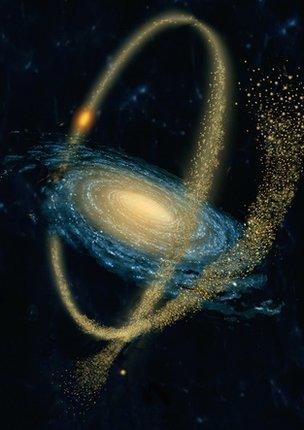Dwarf galaxies gobbled by their giant neighbours
- Published

Stellar streams were seen around the galaxy M 63 - remnants of a satellite galaxy that had been swallowed
Astronomers have spotted the tell-tale signs of so-called dwarf galaxies being digested by bigger spiral galaxies.
Spiral galaxies are known to grow by swallowing their diminutive neighbours; as this process occurs, the dwarf galaxies become severely distorted.
An international team have now observed the characteristic signs of this process occurring in distant galaxies, beyond our cosmic neighbourhood.
The findings are published in the Astronomical Journal.

The observations could shed further light on galaxy evolution
The researchers say the findings could shed further light on the evolution of galaxies.
As dwarf galaxies are digested by spirals, they form tendril-like structures and so-called stellar streams - long filaments of stars produced by the stretching action of tidal forces.
Astronomers have been observing such events in our immediate cosmic neighbourhood, known as the "Local Group" of galaxies, for more than a decade.
But the Local Group, with its three spiral galaxies, is much too small a sample to determine how common this process might be in the rest of the Universe.
David Martínez-Delgado from the Max Planck Institute for Astronomy in Germany and colleagues carried out a survey of spiral galaxies at distances of up to 50 million light-years from Earth.
They discovered the tell-tale signs of spiral galaxies eating dwarfs - the first time this has been observed in galaxies beyond the Local Group, according to the researchers.
Remarkably, the results were obtained with the telescopes of ambitious amateur astronomers.
For their observations, the researchers used telescopes with apertures between 10cm and 50cm, equipped with commercially available CCD cameras.
The telescopes are robotic (meaning they can be controlled remotely), and are located at two private observatories in the US and one in Australia.
The researchers now plan to use the data to test computer predictions of the frequency of features such as tendrils and stellar streams.

Our own Milky Way (seen here from the Paranal observatory in Chile) is a type of spiral galaxy